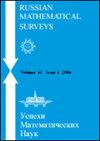关于四维和五维平行四面体的Voronoi猜想
IF 2.1
4区 数学
Q1 MATHEMATICS
引用次数: 0
摘要
1. 平行四面体和Voronoi猜想。如果空间R被平铺成P的平行副本,那么一个凸的d维多面体就被称为平行四面体或d平行四面体。特别地,所有平行四边形和所有有对称中心的六边形都是2平行四面体。费多罗夫在19世纪末对所有五种三平行四面体进行了分类。平行四面体理论起源于费多罗夫、闵可夫斯基、沃罗诺伊和德龙的著作。平行四面体与数学晶体学、晶体群的分类、与整数晶格有关的算法和几何问题,特别是与希尔伯特第18个问题密切相关。Voronoi猜想[1]是平行四面体理论的中心猜想之一。它指出,对于每个d平行四面体P,存在一个d维晶格Λ,使得P与Λ的Dirichlet-Voronoi细胞仿射等效。如果Voronoi的猜想对P成立,那么我们称它为v平行四面体。对于d≤5,Voronoi猜想得到了充分证明。情况d = 1,2,3是常识。d = 4的证明是由Delone[2]在1929年给出的。对于d = 5,证明由本文作者在2019年获得;参见[3]。平行四面体理论的主要结果的回顾可以在b[4],第3章和b[5]中找到。在这篇文章中,我们给出了Voronoi猜想在R中的一个新的证明,它使用了[3]的思想,适用于d = 4。例如,我们的证明依赖于组合方法,而不是德龙的几何方法。这两种方法都使用了平行四面体的一些一般性质,特别是对平行四面体在余维三面的重合类型的分类,以及在某些约束下平行四面体的分层结构的存在。然而,我们依赖的是在德龙发表论文很久之后发展起来的组合方法。最后,我们给出了从[3]证明d = 5的Voronoi猜想的一个草图。本文章由计算机程序翻译,如有差异,请以英文原文为准。
On Voronoi’s conjecture for four- and five-dimensional parallelohedra
1. Parallelohedra and Voronoi’s conjecture. A convex d-dimensional polytope is called a parallelohedron or a d-parallelohedron if there is a tiling of the space R into parallel copies of P . In particular, all parallelograms and all hexagons with a centre of symmetry are 2-parallelohedra. All five types of 3-parallelohedra were classified by Fedorov at the end of the 19th century. The theory of parallelohedra has its origins in the works by Fedorov, Minkowski, Voronoi, and Delone. Parallelohedra are closely connected with mathematical crystallography, the classification of crystallographic groups, algorithmic and geometric questions relating to integer lattices, and, in particular, with Hilbert’s 18th problem. Voronoi’s conjecture [1] is one of the central conjectures in the theory of parallelohedra. It states that for each d-parallelohedron P , there is a d-dimensional lattice Λ such that P is affinely equivalent to the Dirichlet–Voronoi cell of Λ. If Voronoi’s conjecture holds for P , then we call it a V-parallelohedron. Voronoi’s conjecture has been proved fully for d ⩽ 5. The cases d = 1, 2, 3 are common wisdom. The proof for d = 4 was given by Delone [2] in 1929. For d = 5, the proof was obtained by the authors of the present paper in 2019; see [3]. A review of key results in the theory of parallelohedra can be found in [4], Chap. 3, and in [5]. In this note we present a new proof of Voronoi’s conjecture in R, which uses ideas from [3] adapted for d = 4. For instance, our proof relies on a combinatorial approach, in contrast to Delone’s geometric methods. Both approaches use a number of general properties of parallelohedra, and, in particular, a classification of the types of coincidence of parallelohedra at faces of codimension three and the existence of a layered structure of tilings into parallelohedra under certain constraints. However, we rely on combinatorial methods developed long after Delone’s publication. In conclusion, we present a sketch of the proof of Voronoi’s conjecture for d = 5 from [3].
求助全文
通过发布文献求助,成功后即可免费获取论文全文。
去求助
来源期刊
CiteScore
1.70
自引率
0.00%
发文量
12
审稿时长
>12 weeks
期刊介绍:
Russian Mathematical Surveys is a high-prestige journal covering a wide area of mathematics. The Russian original is rigorously refereed in Russia and the translations are carefully scrutinised and edited by the London Mathematical Society. The survey articles on current trends in mathematics are generally written by leading experts in the field at the request of the Editorial Board.

 求助内容:
求助内容: 应助结果提醒方式:
应助结果提醒方式:


